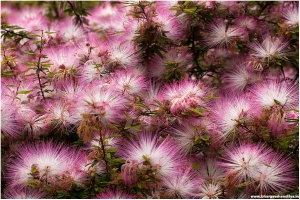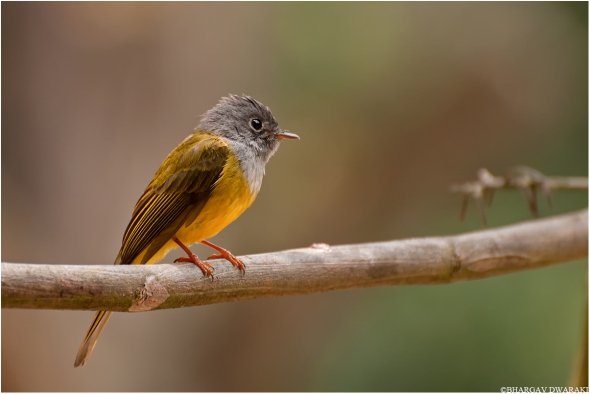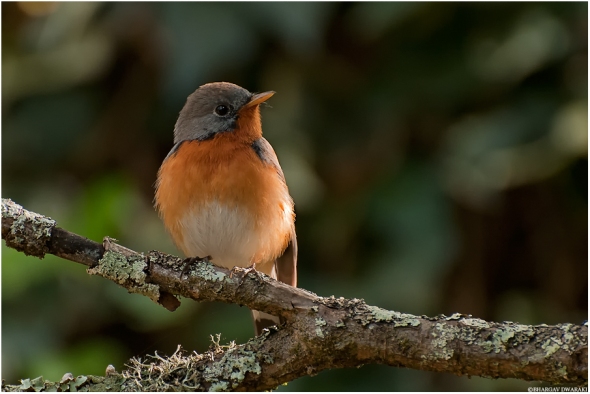Portrait of Rock Agama

Here is a portrait I made yesterday of The Peninsular rock agama (Psammophilus dorsalis) in Nandi Hills, Karnataka.
Rock agamas are a common sight here. I found this particular one on the tree basking in sun. A nice head turn by the agama and the spot light/harsh sunlight falling on it gave me the opportunity to get a nice underexposed background.
Hope you like it. Critics and Comments are welcome.
White-throated Kingfisher

White- throated Kingfisher (Halcyon smyrnensis) is one of the most commonly found birds in and around the city, in fact it is seen more often than the Common Kingfisher (Alcedo atthis), I liked the perch it is sitting on and the background. Hope you like it.
Critics and Comments are welcome.
Photos of Back-Lit Palm Leaf
I made a quick visit to Hebbal Lake early in the morning today, and ended up with the images below.
Kids playing(shouting) Cricket inside the park wasn’t helping for Birding , and I then came across this Back-lit Palm leaf. Hope you like it.
 Monochrome of Back-lit Palm Leaf
Monochrome of Back-lit Palm Leaf
and for those of you who like color, here it is…
Photo of the day

The last few weeks have been very exciting, I am meeting amazing people and learning a lot of things but on the flip side I have hardly taken my camera out! I am re processing old images , I liked this one better than the older color version. I am even planning to print this one 🙂
Green Bee-eater in Rain
which one do you like? This one or the earlier one?
New Life
For those of you who are following this blog, wondering if I’m still alive, let me dispel your doubts on the subject and tell you that I am and very much so! Alive and kicking for all the right reasons too! 🙂 The last seven months have been one hell of a ride and have resulted in my making a life changing decision. The decision being: I quit my day job and turned to a full-time photographer, freelancer and a traveler.
This is exactly what I have wished for all my life, but to say that it was an easy choice would be a far shot. After months of clocking in with the rest of the corporate world, wishing to be out in the wild while sitting in front of my computer, day after day, in anticipation of my next steady paycheck, lots of deliberation and debating with my family later, I realized the only thing left to do was to take that leap of faith. Sticking with a safe job is an easy decision, especially because it means a steadiness that is considered good based on the collective societal belief impressed upon us. Taking a risk on the other hand, comes with a risk. (Duh!) I am happier having taken this route as it means staying true to myself even if it means missing the perk of a fixed moolah at the end of each month and high speed internet acess. (I won’t lie, I dreadfully miss it.:P)
Living the life of a freelance photographer comes with its share of challenges. If I had imagined being self-employed would be tough, the first five months have asserted that through reality. Paying the bills is still a priority as is learning. In this quest, my aim is to get exposed to as many forms of the art as possible. My passion lies with wildlife photography, but I am also working in parallel on commercial photo shoots and travel photography. That being said, it is important to me that the aesthetic of this art is preserved irrespective of the forum.
For my first photo shoot, I had the opportunity of clicking an adorable baby girl, Sameksha and was rather pleased with how I did.
Also tried my hand at wedding photography for my cousin Prashant, who gave me my first camera. Although they liked my clicks, personally I felt I could have done better.
Another wedding assignment followed this and here my learning from the previous shoot, helped me do better.
I did an assignment for a leading travel firm to shoot hotels and resorts in Pondicherry, mangalore and Bangalore. It was fun to work and a great learning experience.
I ventured out into capturing portraits and here are a few clicks.
This month I had a chance to shoot at the Enchanted Valley Carnival where there were about 60 artists performing at Aamby Valley. The experience overall was very rewarding and I got to shoot some biggies like Indian Ocean, ATB and Taio Cruz etc. You can check out the pictures here.
Take a look at my website( http://www.bhargavshandilya.in ) here. The gallery is not fully up yet, but will approach completion in a few days time.
I am always open to feedback , so Feel free to leave your comments.
So if any of you are looking for a photographer don’t even consider going elsewhere. I’m your man! :D:D (All the publicity aside, I’m a really nice person to work with.:P)
If you like my work, then please do share it with your family and friends 🙂
Grey -headed Canary -flycatcher(Culicicapa ceylonensis)
The Grey headed Canary flycatcher (Culicicapa ceylonensis) is an insectivorous and a species of small flycatcher – like bird found in tropical Asia.
This species breeds in upland to montane oak and other broadleaved forests and similar wooded areas in temperate to tropical southern Asia, from Pakistan, Central India and Sri Lanka east to Indonesia and southern China. Many populations are resident, but some Himalayan birds are partial migrants that winter in Peninsular India sometimes even occurring in arid habitats.
The Grey-headed Canary-flycatcher is about 10 cm long with a squarish grey head, a canary yellow belly and yellowish-green upperparts. They forage actively like flycatchers and perches in a very upright posture. The sexes are indistinguishable in plumage. They have a very flat bill which when seen from above look like an equilateral triangle and is fringed with long rictal bristles.
The Grey-headed Canary-flycatcher is an insectivore and like flycatchers makes sallies for aerial insects from a low perch under the canopy of a tree. A pair may forage together and they will often join mixed -species foraging flocks.( Source – Wikipedia)
As we(myself and Vinod ) reached Ooty, we made a list of species that were special from this region .We wanted to spot and photograph each of them.Apart from the commoners like Mynas and Sparrows ,the first bird which we saw was this little Grey headed Canary-flycatcher. Though we spotted it quite easily and spent close to two hours ,I could not make a descent picture as it used to sit up high in trees or on the grills.Next day morning too went with out much luck (in terms of Photography), later in the day I saw it perch on a branch with less or no clutter .I went there and I was waiting for it to come back ( yes,these birds do perch on the same place), initially I missed few shots but this bird had kind of got used me and gave an other opportunity. Light was little harsh but I will take it!.Hope you like it 🙂
Have a great Day 🙂
Cheers,
Bhargav
Kashmir Flycatcher (Ficedula subrubra)
The Kashmir Flycatcher(Ficedula subrubra) is a small passerine bird in the flycatcher family Muscicapidae.
This is an insectivorous species which breeds in the north-west Himalayas in the Kashmir region. It is migratory and winters in the Western Ghats and in the hills of central Sri Lanka.
It is 13 cm long.The male has a grey-brown back with an orange-red throat, breast and flanks, bordered with black on the throat and breast. Females and first-winter birds have slightly browner upper parts, and the red of the underparts reduced to just a pinkish wash.
The Kashmir Flycatcher breeds in deciduous forest with dense undergrowth, nesting in a hole in a tree and laying 3-5 eggs which are incubated by the female. It winters in gardens, tea estates, forest edges, and open areas within forest, generally above 750 m.
The song is a short melodic sweet-eet sweet-eet-did-he, and the call is a sharp chak.
This migratory flycatcher is a vulnerable species with a decreasing population and breeding range, which is also severely fragmented as a result of the destruction of temperate mixed deciduous forests by commercial timber extraction, agriculture and livestock grazing.(Source – Wikipedia)
Both photos were taken in Ooty ,using Nikon D300s.Nikkor 70 – 300mm VR lens.
I had been to Ooty with Vinod during the last week of march. It was a good birding trip. We got to see this rare bird along with many endemic species(including Black chinned Laughing Trush or Nilgiri Laughing Trush ). I made some good images of Grey headed canary Flycatcher and Nilgiri Flycatcher (will post them soon) , I will definitely go back to photograph the endemics. We had gone in an open jeep and it was great, we had to embrace the scorching heat and rain!(will tell more about this later)
Have a Happy Weekend 🙂
Cheers,
Bhargav
Tickell’s Blue Flycatcher (Cyornis tickelliae)
The Tickell’s Blue Flycatcher (Cyornis tickelliae) is a small passerine bird in the flycatcher family. They are insectivorous species and are found in dense scrub to forest habitats.
It is a sparrow sized (14cm ) bird , it perches bolt upright a couple of meters from the ground,flicking its tail and uttering a sharp tick,tick from time to time.
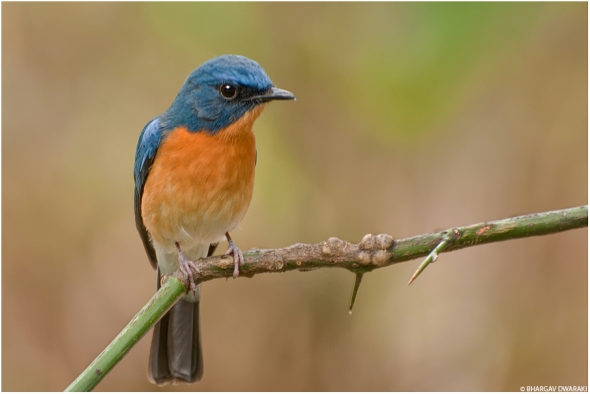 Tickell’s Blue Flycatcher
Tickell’s Blue Flycatcher
Male has the upper parts indigo blue and their forehead,supercilium and shoulders are azure blue , the throat and breast are orange – rufous and has white belly.Females are similar to male but are duller in color.
 Tickell’s Blue Flycatcher
Tickell’s Blue Flycatcher
They feed mainly by capturing insects in flight but their prey include other insects such as termites and earwigs that may be gleaned or picked from the ground.They have an unmistakable call which sounds tick – tick.( Source – Wikipedia and Handbook of the birds of India and Pakistan)
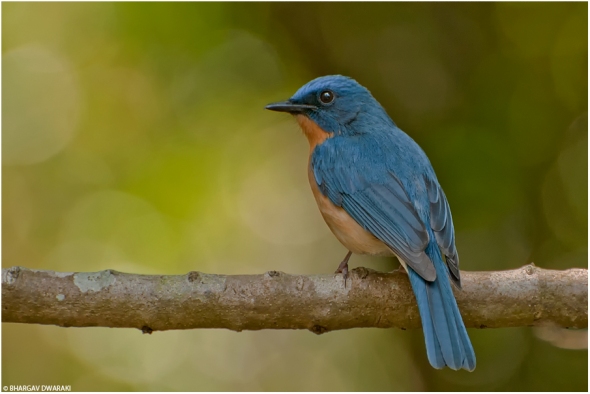 Tickell’s Blue Flycatcher
Tickell’s Blue Flycatcher
All 3 photos were taken in Nandi hills using Nikon D300s ,Nikkor 70 – 300mm VR lens.
Comments ,critics and suggestions are welcome 🙂
In the past 3 months I have made many visits to Nandi Hills and I Have struggled to photograph here because of the tricky light condition . Out of several visits I have made , only the last two were good in terms of photography and I learnt how to handle the camera in such condition.There is so much to learn!!And I am learning (slowly though). Saying that , every time I go to Nandi Hills I have a surprise waiting there each time. During each visit I get to see and learn something new , the last one being sighting of Pied Trush (Zoothera wardii) 🙂 . I really hope this continues 🙂
On a personnel note , I completed 23 years few days back and also completed 1.5 years in office. Office is frustrating like never before I think I was confident of doing something (in life) when I was jobless and sitting at home than now (while working). Hope things get better(Soon , Plz!!).
Cheers,
Bhargav
Indian Roller (Coracias benghalensis)
Indian roller is one of those few birds I knew before I started bird watching as they were very commonly seen perched along roadside wires and trees en route to my native.
The Indian roller (Coracias benghalensis) gains its name from its elaborate courtship displays, during which it performs some startling aerobatics culminating in a series of ‘rolling’ motions. The Indian roller is a medium-sized bird (26–27 cm ).The breast is brownish,the crown and vent are blue.The primaries are deep purpulish blue with a band of pale blue.The tail is sky blue with a terminal band of Prussian blue and the central feathers are dull green.The neck and throat are purplish lilac with white shaft streaks.The three forward toes are united at the base.Its eyes are greyish-brown and the strong, hook-tipped bill is blackish-brown. (Source –Wikipedia , Arkive)
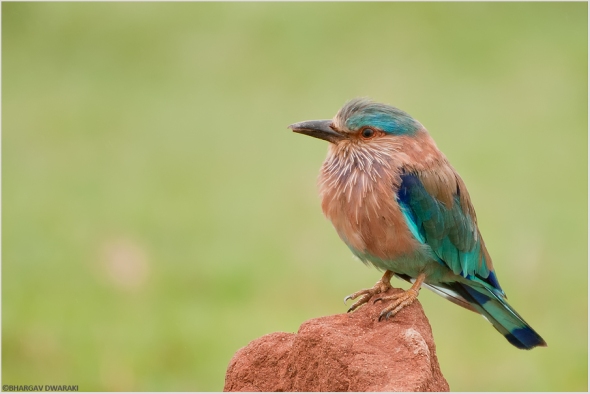 INDIAN ROLLER
INDIAN ROLLER
Its local name is Neela Kanta (meaning “blue throat”).This colorful cousin of the migratory Eurasian Roller was formerly called Blue Jay and is also the state bird of Karnataka.
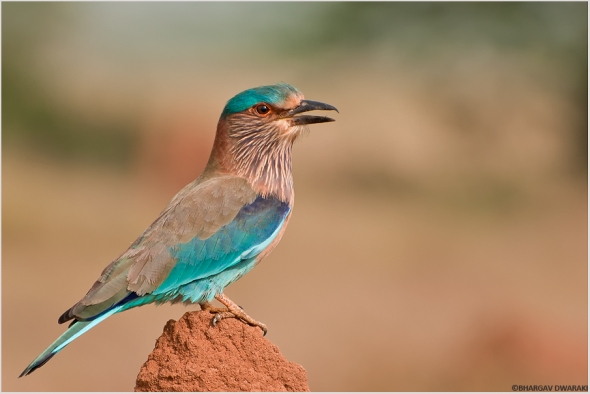 Roller Calling
Roller Calling
First image was shot in October while the 2nd was in December 2012,in Hessarghatta.
This bird feeds primarily on insects, in particular beetles, crickets, and grasshoppers. It also regularly consumes flying insects such as wasps, flies, moths and butterflies . Where available, amphibians also form a large part of its diet.It prefers open cultivated areas or light deciduoud forest. (Source – Arkive )
In flight , Indian Roller is a spectacular sight to watch. I have tried capturing flight shot but haven’t been successful yet! 😦 . Will post that as and when I get.
Critics and comments are welcome 🙂
Cheers,
Bhargav
Birds in my Backyard
Last weekend, I went looking for Bar Headed geese , whose sighting had been reported from Hassan. Unfortunately, since I couldn’t get the transport to get there, I had to spend two days in my village. My bad knee didn’t allow me walk so I was pretty much at home the whole time, watching the winged visitors in my backyard.
Now about my backyard, picture this — the last wall of my house also acts as a compound on one side, on the other end of this is a barbed wire fence, hardly visible as the Lantana has covered it completely. To the left there is lifeless wall made of mud, only about knee-length in height and doesn’t serve any function a compound should; to the right is the wall of our Rice Mill. It is big and has quite a few trees. To the left of the house wall, Hibiscus has grown into a tree, next to which is a big Neem tree and farther away from it are two Coconut trees. On the south west left corner of the plot, there are two Teak trees and to its right is another Neem tree, surrounded by Lantana. On the top right side corner of the plot, there’s a heap of Paddy husk from the mill and this attracts lot of birds that come in search of food.
From August to October the birds I’ve noticed are Baya weaver, Indian silverbill, Black headed munia, Scaly breasted munia , House sparrow ,White throated Munia etc . There were at least a 100 baya weaver birds which would come to feed on the paddy husk. They had built their beautiful nests next to our plot on a Tamarind tree. Scaly Breasted munia also came in large numbers and I think along with silverbills and other munias,they had built their nest in the lantana or the nearby bushes , as I spotted them there most of the time.Baya weavers, munias and sparrows later in the evening would sit on the electric wires in front of the rice mill , some used to preen their feathers and most of them simply sat and used to sing . It was quite a sightto watch 100s of birds sitting almost next to each other.
In november , I made a single visit to this place , and other than the above mentioned birds , I could hear the pecking sound of the woodpecker on the coconut tree – but before I could get to see it, it had gone. I am guessing it could be a Flameback Woodpecker, as I have seen one not far away from my place on a coconut tree.
During my last two visits, I saw new visitors to this place . I could see a Brown Shrike happily singing, on the top left corner of the plot where the dry corn stalks are dumped.Also, I saw an Asian Koel pair. They are usually seen on the plot next to ours which has more trees and bushes, but they do visit our plot regularly. Red whiskered bulbul was seen on a Neem tree whereas its cousin Red vented Bulbul was spotted on a Lantana. House Sparrows which used to restrict themselves to the Rice mill can now be seen near the paddy husk and also near the front side of the home. I also saw
a White cheeked barbet on a dead tree next to our plot. Blue Rock pigeons, which have made the Temple Gopuram (close to my plot) its house, comes in a gang to feed. Purple rumped Sunbird pair calling to each other was seen on lantana and also near the Hibiscus tree. Ashy prinias call can be heard but I haven’t seen it yet.
Apart from the above birds, Common Mynas and Yellow bellied Babler can be seen anytime near the bush on the top right corner of the plot close to paddy husk. House Crows are always seen either cleaning the plot or attacking the Three striped palm squirrel present near the Teak tree. Apart from these there are other small birds which I couldn’t Identify.
These are the Birds which I have seen in my backyard to date. I am sure that there are more birds which I have not spotted as yet, will update as and when I see. Though I saw all these birds here, this place is not good for photography (Lantana and bushes never give you the background which you want and the tall trees doesn’t help you either.
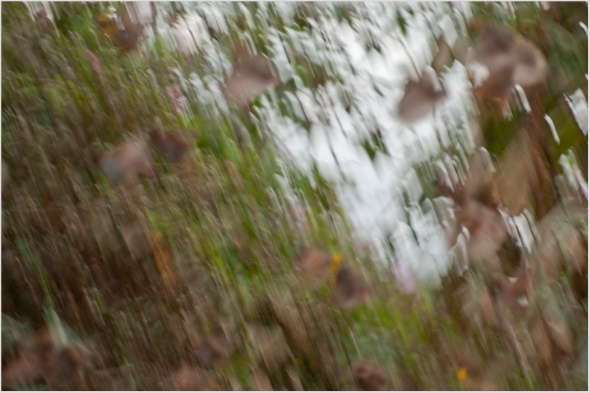 Speed
Speed
Baya weavers and Scaly Breasted Munias were happily feeding on paddy husk. The moment they saw me, they all were up flying with great speed.
Last Sunday, I went around my village looking for birds. I could spot 37 dfferent kinds of birds of which the highlights were White wagtail(First Timer for me ) and Grey Francolin (First time I saw this here) .It is so much fun to go to a place without knowing what to expect and find everything on your own.
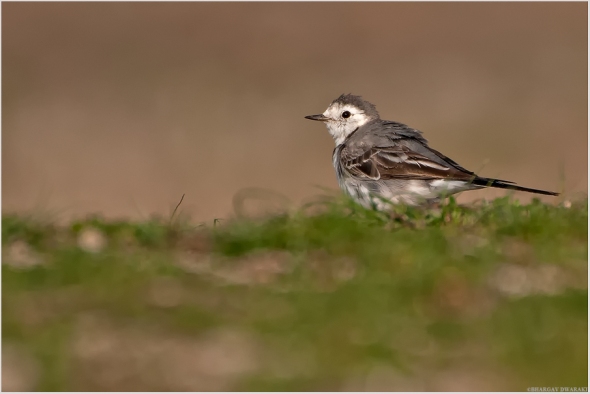 White Wagtail
White Wagtail
Have a Happy Weekend 🙂
2012
2012 has been good. I bought my first Camera in August and have been doing quite well . When I started photography,I would just push the shutter button many times when I saw something, hoping that one would come out good. Now I use a more calculated approach, lots left to learn though .
I met some amazing people and made some good friends . I haven’t traveled and trekked ,as much as I wanted to but will make up for it this year 🙂
Well, 2012 has been the best year of my life so far. I hope 2013 gets better than that 🙂
Happy new year people , Thanks for the support .Have a great year ahead 🙂
 Happy 2013:)
Happy 2013:)
Common Kestrel (Falco tinnunculus) – Female
The Common Kestrel (Falco tinnunculus) is a bird of prey species belonging to the kestrel group of the falcon family Falconidae.It is a bird of farm land and open areas. It is known for the way it hovers above the ground , in search of prey.
It is a medium- sized (32- 29 cm ) falcon with long wings and tail.Plumage is light chestnut – brown with blackish spots on the upper-side and buff with narrow blackish streaks on the underside.The sexes are distinct, in males the rump and tail are bluish grey and unbarred,whereas in females they are brownish – red with dark barring.The head is grey in males and brown in females.( Source – Wikipedia)
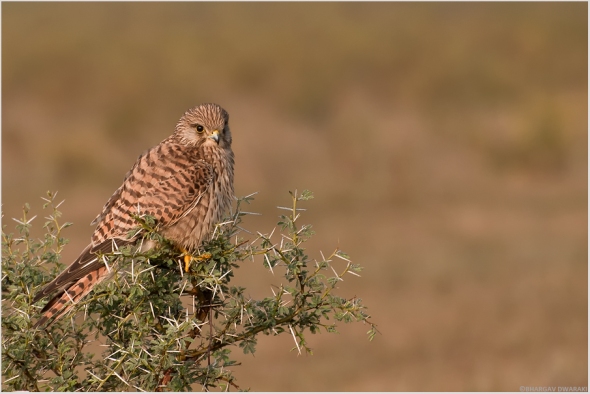 Common Kestrel
Common Kestrel
10th November, was a good day for me. Prior to this , I have tried almost a month to photograph this lady. Though I had managed to take few shots,I was not happy with it. On this day, I spent a good amount of time with her, I saw her Hoover , I saw her preen , I saw her catch insects. I managed to click shots which I wanted.
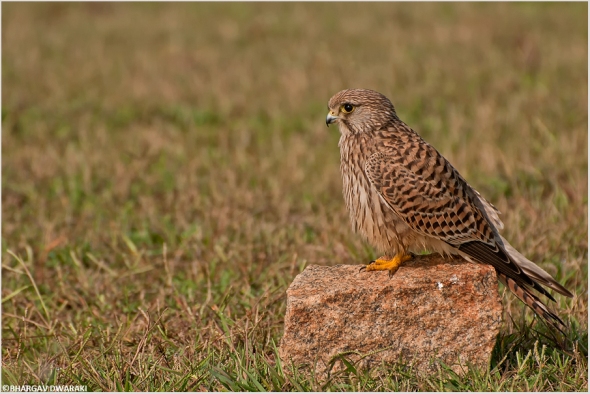 Ground Level shot of Common Kestrel
Ground Level shot of Common Kestrel
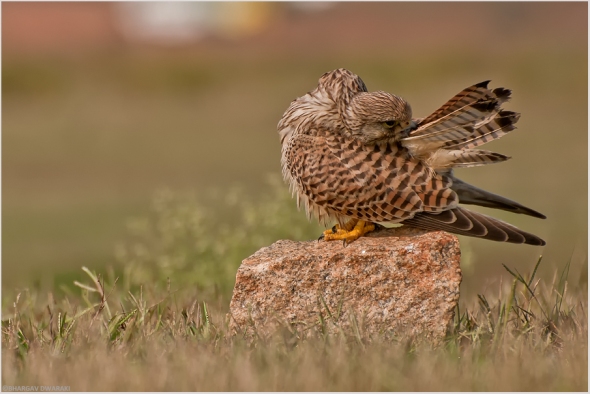 Common Kestrel – Preening
Common Kestrel – Preening
Please click HERE to read about Preening.
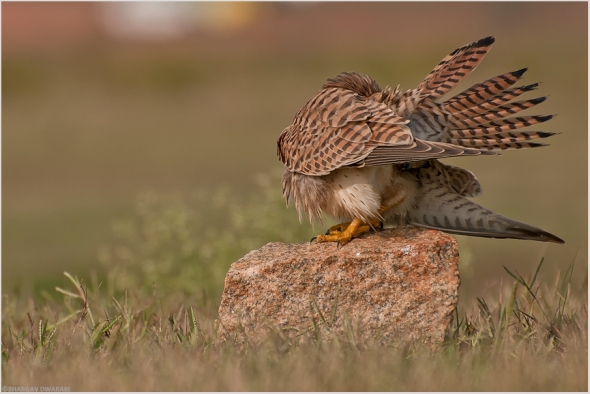 Lost in Preening
Lost in Preening
(Can you spot the head?)
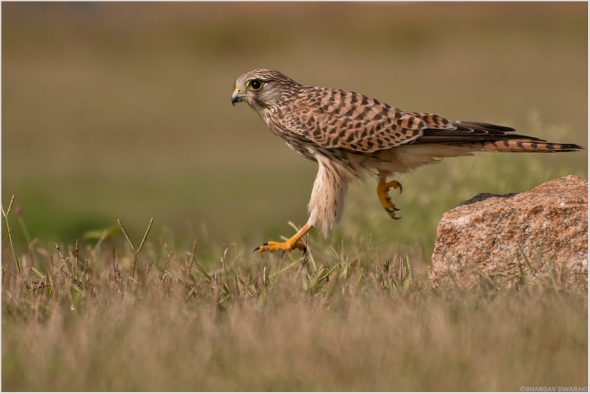 Jumping Kestrel
Jumping Kestrel
The below image was taken on 1st November and it is special to me. It was raining here in Bangalore for almost a week (remember Cyclone Nilam?), I had no plans of going for birdwatching or for photography as I thought it would rain , My friend (Hemanth) called me the previous night and asked if we can go, if there is no rain. On this day, it was drizzling but we thought it would stop and went ahead with the plan . But , the drizzle slowly picked up for our bad, added to that going in activa made it even more difficult for us. Mud went inside all possible parts it could go to and we had tough time cleaning it. It was still drizzling and was impossible to go back in the same path , we planned to take the other exit . On the way to exit , we stopped to take a photograph of a Paddy field Pipit but to our luck this beauty came and perched close to where we were.It was first time I was that close to any bird , I could see the details of it just with my eyes. I still cannot forget that eye contact. Got my first Portrait this day ! .Sometimes things just happen 🙂

A Portrait
The Kestrel feeds largely on small mammals, and small birds.Invertebrates are also very important components of the diet.Kestrels hunt by sight,upon spotting their quarry,they plunge to the ground ,seizing the prey with their talon.(Source – Arkive)
Kestrels, when hovering are able to stay still even in strong winds. I have seen one on top of Tadiyandamol hover against strong winds.
Nikon D300s,Nikkor 70-300mm VR lens , in Hessarghatta.
Hope you all had a great weekend ,Good Night 🙂
Scope for Improvement
Last to weeks have been very busy , something or the other kept me busy.I had to work last saturday 😦 Being in the Office on a saturday is no fun , it really sucks!On a positive note , I read two brilliant book’s. One , ” The Fall of a sparrow ” ( Salim Ali) – Thanks to Reliance Time Out 😛 , 2nd one being “ Of Birds And Birdsong” ( M Krishnan).
It is always Exciting to photograph Small birds. They are colorful,they are active most of the time and at times they are difficult to photograph.
(Among many things) One thing I want to improve is, I want to capture shot that shows behavior than a shot that shows only the existence of the bird. For that , I have to be patient , observe , read and learn about my subject (which I am doing) . Saying that , I understand that I can take it to that level if I can go beyond the simple shot . And of course , I am not taking anything away from existence shots as they are quite pleasing in themselves .
 Siberian Stonechat (Male)
Siberian Stonechat (Male)
(Please click on the picture )
(Please click HERE and HERE to check older picture’s of Siberian Stonechat)
Do let me know the area which you feel I should work on, to make it better. Thanks in advance 🙂
Comments, critiques and suggestions are welcome.
Cheers,
Bhargav
Egyptian Vulture (Neophron percnopterus)

Egyptian Vulture (Neophron percnopterus),also called the scavenger vulture. It has an unmistakable appearance, possessing white plumage with black feathers in the wings and tail . They have bare yellow face and the bill is large and narrow with a curved tip. The legs are pink in adults and grey in juveniles.Young birds are blackish or chocolate-brown with black and white patches.
 Egyptian
Egyptian
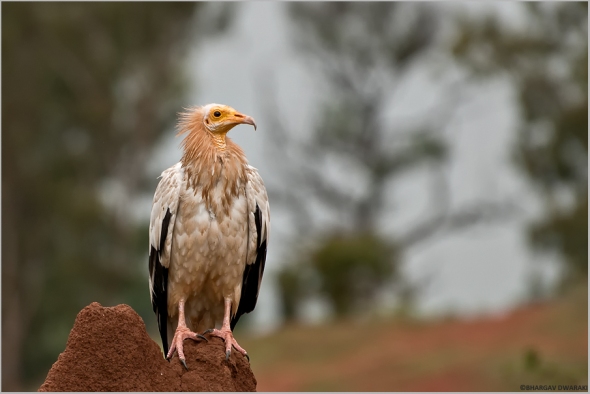
They are also called as Pharaoh’s Chicken
Egyptian Vultures feed mainly on carrion but are opportunistic and will prey on small mammals, birds, and reptiles.
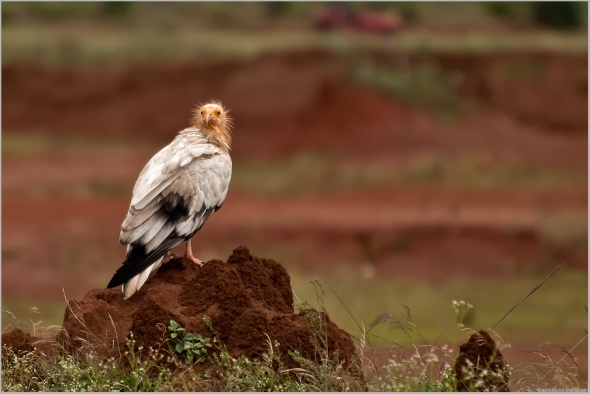
Conservation status of Egyptian Vulture is ENDANGERED , according to IUCN Red List.
The light was not on my side , this is the best I could do. Hope you like it.
Critics and comments are welcome 🙂
Light & Moss

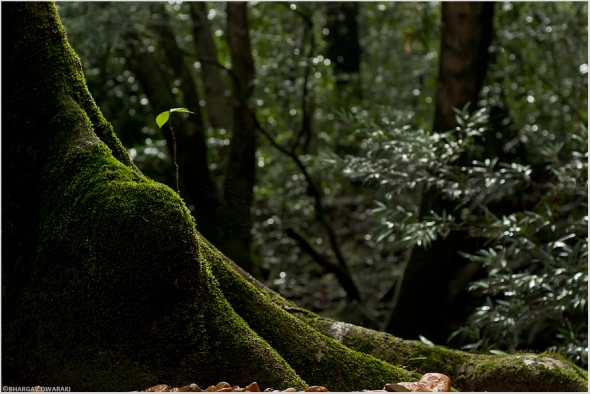 Light & Moss
Light & Moss
Mosses are small,soft plants .They commonly grow close together in clumps or mats in damp or shady locations.They do not have flowers or seeds,and their simple leaves cover the thin wiry stems.( Source – Wikipedia )
This picture also shows the lighting in Forest floor. The forest floor is usually shaded ,except where a canopy tree has fallen and created an opening. A small percentage of light that strikes the top of the forest penetrates to the forest floor.
Here, the moss is grown on buttress of tree. Will write more about buttress and canopy in coming posts 🙂
Taken in Agumbe , with Nikon D300s and my friends Nikkor 18- 55mm VR .
Cheers,
Bhargav
Photo Of The Day – Ashy – crowned Sparrow Lark (Female)

 Ashy – crowned Sparrow Lark – Female (Eremopterix griseus)
Ashy – crowned Sparrow Lark – Female (Eremopterix griseus)
Click HERE and HERE to see the photo of Ashy – crowned Sparrow Lark – Male.
Have a nice day 🙂
Red Wattled Lapwing (Vanellus indicus)

The Red Wattled Lapwing (Vanellus indicus) is a widespread resident in India. It is so called for the vivid red ,fleshly ,wrinkled skin or wattle ,in front of each eye.
 No Lapwing ,I didn’t do Anything!!!
No Lapwing ,I didn’t do Anything!!!
It is also known as the ‘Did you do it’ bird, as the bird’s call sounds like ” did you do it”.
Nikon D300s,Nikkor 70 – 300 mm VR, in Shantigrama.
Common Kingfisher (Alcedo atthis)

Remember What a Day?? (click HERE ,if you don’t! ). It happened on that day(and on last weekend) .
Birds are very good posers, but unfortunately only for those who sit inside a car and click. For someone like me (who is on foot most of the time), they spot you before you see them and fly off. Having said that, I won’t complain. Its fun this way and I enjoy every bit of it.
Common Kingfisher is one of the many colorful and beautiful birds which every photographer likes to have a shot in his collection.Till this day, though I had seen it many times, I didn’t have even one good shot of this for some reason.
It was a lovely morning, I was walking on the bank of a small pond which is few km from my house, I noticed the Common Kingfisher perched on a small plant, looking for fish. Before I could do anything else it flew off from there (one more chance missed) and perched on a small distant twig. I decided to walk around the bush and stopped at a safe distance from the twig. I waited there for a while and let off few frames. From there, the bird was too small in my lens. Lying flat on the ground, I crawled slowly towards the bird. Slowly the bird started looking big (definitely not full frame) in my lens. It’s not that bird didn’t notice me, but it was probably preoccupied looking for fish.
I stopped at a comfortable distance and spent a lot time in front of it. It was worth every minute, I saw it look for the fish patiently, dive into water (they are avid divers), scaring the other Kingfisher which came towards it, catch and miss fishes, shaking the water off its body. This process kept on repeating. So amazing was the experience that though I missed many shots, I managed to take some decent ones in the end.
Let me introduce you to the bird itself,
Common Kingfisher (Alcedo atthis) is one of the most colorful and instantly recognizable birds. The upper parts are blue while the underparts are orange in color.The bill is very – long and dagger like. The Kingfisher feeds mainly on fish and invertebrates, which it catches by perching on a convenient branch. They usually sit on low-hanging branches or bushes right above the water or on small plants that spring up in the middle of shallow waters and dive into the water when prey comes within striking distance.
One strong Kingfisher:)
Well, its not about to fly or its not calling!! If you look at it carefully, there is one more Kingfisher flying towards it. This screamed and scared the other ‘fisher. This is not that good a pic, but I have put it here to show this behavior!!(how I wish the water didn’t reflect the white sky!).
This is how they look for fish.
As I mentioned earlier, Kingfishers are avid divers. After a dip into the lake and catching its prey, this is how they shiver the excess water off its body and batter the fish. This is my FAVORITE pic. For me, this represents the bird.
Click HERE to see color version of this.
On the way back home, though I wished I had an extra 100mm (which I can only wish for now 😦 ), I had a rare smile on my face. It is not often that things happen the way the you want and when they do happen, you should completely enjoy it!
Nikon D300s,Nikkor 70 – 300 mm lens, lying flat on ground.
Have a great Sunday.
The Rising Star

As I had told before,I trekked Tadiyandamol last weekend.Tadiyandamol, located at an elevation of 1,748 m (5,735 ft) is the highest mountain of Kodagu district,Karnataka and is also the 3rd highest peak in Karnataka.It is on the Western Ghats range and has patches of shola forests in the valleys.
Tadiyandamol is one of the easiest trek I have done so far and one of the beautiful places I have been.
Rising Star
Morning was extremely windy,I was literally carried away by the wind (now,that’s too much :P) but it was worth every minute .It was amazing to see the clouds envelop the landscape.
I spotted Plum headed Parakeet,Shrike,Bulbul’s ,Wagtail and oriental magpie Robin in the lower range and what’s worth mentioning is Common Kestrel .Saw this at the top most point , it was amazing to see it hovering against strong winds.
Hope you like it .Comments, critiques and suggestions are welcome.
Note: The last pic is not from Tadiyandamol.
Eurasian Roller (Coracias garrulous)

Eurasian Roller ( Coracias garrulous) also known as European rollers ,are migrants to our country and are near threatened species. They have colorful plumage .The head ,neck and underparts are light blue,while the upper parts are brownish -orange.A short ,thin black stripe runs through the eye.The tail is greenish- blue with a darker base.
Nikon D300s,Nikkor 70-300mm VR, f6.3,1/1000sec,ISO 400.
It feeds on invertebrates such as beetles, crickets, locusts, caterpillars, flies and spiders.
Nikon D300s,Nikkor 70-300mm VR, f6.3,1/800sec,ISO 400.
I first spotted this beautiful bird a day before this picture was shot but couldn’t capture the shot as too many people came in and frightened the bird away with all the activity 😦 . Luckily ,the very next day this bird flew to the place we were waiting .All we had to do was, just position our self at comfortable distance and click .
 Nikon D300s,Nikkor 70-300mm VR, f6.3,1/800sec,ISO 400.
Nikon D300s,Nikkor 70-300mm VR, f6.3,1/800sec,ISO 400.
Hope you like it 🙂
Meanwhile ,I trekked Tadiyandamol (Highest peak in Coorg range also 3rd highest peak in Karnataka) last weekend. It was brilliant, caught some good shots,will post them soon.
Have a nice day 🙂
Siberian Stonechat (Saxicola maurus ) Male

Hi All,
Hope you all had a great weekend. Here is a picture of Siberian Stonechat (Saxicola maurus) male ,which I shot on saturday. I am not a big fan of completely plain background , I would like to show texture but in this case there was hardly anything behind the bird.
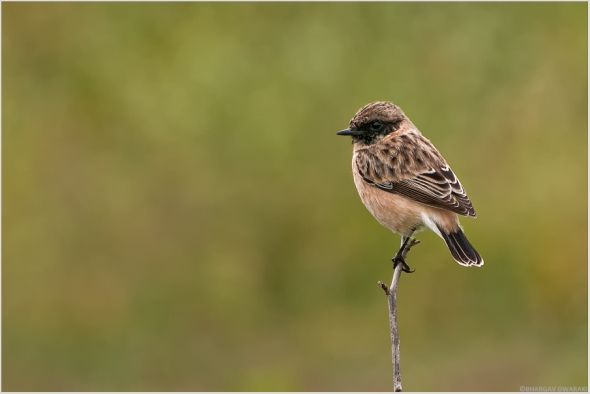 Solitude
Solitude
(To check the Photos of Siberian Stonechat Female,click HERE)
This weekend was good in terms of sighting and photography ,though it was raining most of the time.I Saw Twany Eagle ,Egyptian Vulture and European Roller for the first time and made some good images of Vulture and Roller ,Twany Eagle was too far for my lense .Will post them soon.
Also , I visited photography exhibition – ‘Where The Wild Things Are’. It is a photography exibition of recent works by Kalyan Varma, Ganesh Shankar , Jayanth Sharma and Aditya Singh. It was awesome. The feel of looking at prints was just brilliant and different.If you are in bangalore ,don’t miss it . It is on till the 26th of this month at the Five Forty Five, the art gallery in Indiranagar. 545, 6th Main, 4th Cross, Indira Nagar Stage II, Bangalore, India 560008. Trust me, you wont loose anything.
Have a great day 🙂
Photo of The Day – Juvenile .Brown Shrike

Brown Shrike (Lanius cristatus) is a small bird (18-19cm) belonging to Shrike family.This little fellow is sub adult,adults have reddish-brown upper parts and tail.The wings will be of darker brown color while the lower plumage will be off white.
Nikon D300s,Nikkor 70-300mm VR, f6.3,1/1600sec,ISO 5oo,on a cloudy(rainy) day in Hessarghatta.
See you soon:)
Cheers,
Bhargav
Paddyfield Pipit (Anthus rufulus)

Paddyfield Pipit (Anthus rufulus) is a small(15cm) passerine bird, the upper plumage is mainly streaked in grey brown with patches of black.It is long-legged with a long tail and a long beak.The iris and bill is brown,legs are of flesh color.
Nikon D300s,Nikkor 70-300mm VR, f6.3,1/1250sec,ISO 250,Hessarghatta.
It is seen in open habitats, such as bare grounds or grasslands, short crop cultivated lands etc.
Nikon D300s,Nikkor 70-300mm VR, f6.3,1/1600sec,ISO 250,Hessarghatta.
Its call is “chip-chip-chip”, It feeds principally on small insects but consumes larger beetles, tiny snails, worms etc.(Credit – Wikipedia)
Good Night 🙂
Pied Bushchat (Saxicola caprata ) Female

Here is another post on Pied Bushchat Saxicola caprata, but this time its Female. For details and earlier post please click Here.
Have a good day.
Cheers,
Bhargav




